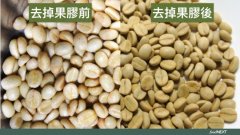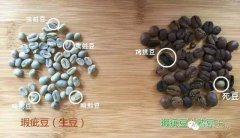The gap between high-quality coffee and instant coffee powder, defective beans affect the quality and flavor

Professional barista communication, please pay attention to coffee workshop (Weixin Official Accounts cafe_style)
The aroma of a cup of coffee reminds us of the importance of proper preservation of raw materials during the food journey. The quality of coffee beans affects the flavor of drinking. Even improperly stored coffee beans may contain toxins. Long-term drinking may have an impact on health.
Fine coffee by standards.
"When we purchase raw beans, we will need manufacturers to provide raw bean samples for self-roasting. After cup testing, we will confirm the moisture content of this bean and other items. Officials can identify whether it meets our needs." Liao Qiaoyu, a certified appraiser of the International Coffee Quality Society, explains that whether raw beans have defects will often be reflected in the changes in flavor. The color of the appearance of raw beans has a considerable relationship with the shape of the beans and the processing method. Fine coffee beans are certified as fine coffee beans by the American Fine Coffee Association (SCAA) Standard Specification for Class I and Class II Defects, and by the American Green Bean Standard and Cup Testing System Basic Score.
Instant coffee powder at a low price
Han Huaizong, author of Fine Coffee Studies, who has studied coffee for decades and visited major coffee-producing countries, points out that the price of a cup of coffee can usually be used to extrapolate the cost of coffee beans and guess the grade of beans. For example, most of the fine coffee is vacuum-packed from the famous manor beans by air, the source is determined, and the raw bean manufacturers will be carefully screened when importing baking, so the price will be high. The convenience of super commercial coffee beans must be cheap commercial coffee beans, green bean manufacturers will use computer machines to do rough screening, but still inevitably contain a few defective beans, but look at a cup of only 35 yuan, also can not require a fine grade flavor.
Origin is defective beans. Control level one.
Coffee on the market comes from coffee beans. The three major coffee producing countries are Brazil, Vietnam and Indonesia. These coffee beans are produced in large quantities in equatorial and southern hemisphere countries. It may be that during long-distance transportation, coffee beans produce mold or ochratoxin A due to improper preservation. In addition, coffee beans may often be due to improper processing of harvesting and roasting, resulting in defective beans. With global warming, defective green beans screened from producing areas are increasing year by year.
Defective beans refer to black and brown beans in green beans, immature, with insect bite marks, beans containing twigs and stones, picked and processed in different places, according to the quality of coffee beans for grading, the allowable number of defects is different, when the number of coffee defects is 50 per kilogram (50 per kilogram), it actually means that coffee per kilogram can not exceed 50 defective beans.
The coffee beans bought by ordinary consumers are usually cooked beans that have been roasted, and it is impossible to see whether they are defective beans; the raw beans picked in the place of production after washing or sun exposure tend to be light brownish green, defective raw beans can be identified from the appearance of moldy, black beans and sour beans can be obviously picked out.
At the end of the coffee season in Central America, Guatemala will pick and sell unripe coffee beans. This kind of beans are easy to dry flat and crack because the flesh is not well grown and the appearance is still green fruit. Nine out of ten will also be defective beans after roasting. Lin Zhehao, director of the Taiwan Coffee Research Institute project, said that drinking such coffee will not affect health, and after deep roasting processing, it can still become food-grade coffee beans.
According to the International Coffee Association, the percentage of defective beans is as high as one in four. What about the hundreds of tons of defective beans that are produced every year? Like most produce, defective beans are like "extras" and it would be a shame to throw them all away.
Therefore, the bean processing plant will classify the beans as "defective beans without affecting flavor". After roasting, grinding, extraction and drying, after confirming that they meet food safety guidelines, they will be made into instant coffee powder-a water-soluble dry product obtained by water extraction. The "instant coffee powder" in the three-in-one coffee bag is usually imported directly from the coffee producing countries: Brazil, Vietnam, Indonesia, India, etc., or the port trading countries Malaysia and South Korea.
Common canned coffee, is a blend of coffee drinks, ingredients have "ground coffee powder", this type of coffee source is imported raw beans, baked and ground in Taiwan, and then added to the coffee product after extraction and filtration, according to law can also be labeled as "coffee extract (substance)", interesting is that canned coffee, whether advertised as mantling, blue mountain and other different flavors, but after the food factory flavor pointer control, so although raw beans from all over the world, After all, coffee is standardized.
Important Notice :
前街咖啡 FrontStreet Coffee has moved to new addredd:
FrontStreet Coffee Address: 315,Donghua East Road,GuangZhou
Tel:020 38364473
- Prev

How much are you willing to pay for this cup of coffee during the whole process of manual processing of raw coffee beans?
Communication of professional baristas Please follow the Coffee Workshop (official Wechat account cafe_style) Writing = Huang Yiling I once did a crazy experiment in which a relative of a neighbor grew coffee in Nantou water, so he gave me a bag of coffee beans. I was actually a little dumbfounded when I received it. I didn't quite know what to do with the bag of coffee beans, and I looked up a lot of data on the Internet for this. I got it.
- Next

The roaster must learn how to select qualified raw coffee beans and screen defective beans.
For professional baristas, please follow the Coffee Workshop (Wechat official account cafe_style) article for heavy coffee knowledge readers, or those who plan to become bakers, purchase notes before buying raw coffee beans. It takes patience to pick beans. Author = Han Huaizong's fine coffee extracted from shell beans must be based on the bean's (1) defect level (2) before being exported.
Related
- Why are the coffee in some coffee shops not enough after being frozen? What should I make up for my American latte cappuccino coffee after being frozen?
- How much water does it take to steam coffee by hand? Why is the coffee brewing and steaming time 30 seconds? What is the purpose of steaming coffee?
- The suspected drink contains too much caffeine! Overlord Tea Lady responds urgently!
- Starbucks rejects antique paper coupons?! Netizen: Missed marketing opportunities!
- What ratio of water temperature and ground does the smart cup method use to press coffee? The difference between brewed coffee and filtered coffee?
- What is the standard process for the purpose of coffee cup testing? What is the difference between hand-brewed coffee and cup testing?
- How to use hand-brewed coffee paragon small golden balls? How does cold coffee lock in the aroma of coffee?
- Is American coffee black? What is the difference between American coffee and drip coffee?
- Unexpected! Well-known tea beverage brand Lele Tea will withdraw from the Zhengzhou market!
- Starbucks enters the fashion and beauty industry?! Netizen: Give me an ice American eye cream

